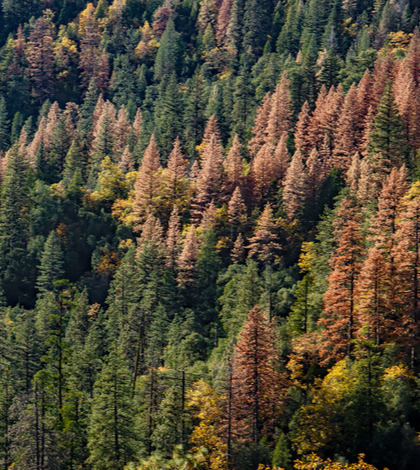According to a symposium held in July 2017 by the United States Department of Agriculture on Drought and Tree Mortality in the Pacific Southwest Region, over 129 million California trees on 8.9 million acres died between 2010 and 2017. The southern Sierra Nevada was the most heavily impacted region.
Now, researchers from the University of California (UC), Irvine and UC Merced have outlined in a study published this week in Nature Geoscience what they have found to be the primary cause of the catastrophic die-off — the inability of trees to reach diminishing supplies of subsurface water following years of drought and abnormally warm temperatures. The most severe period of tree die-off was 2015-16 and was the focus of the UC researchers’ study.
“In California’s mixed-conifer mountain forests, roots extend from five to 15 meters deep, giving trees access to deep-soil water,” said co-author Michael Goulden, UCI professor of earth system science. “This is what has historically protected trees against even the worst multi-year droughts.”
But many forest stands exhausted accessible subsurface moisture, leading to widespread tree death and exceeded the safety margin which normally would have protected the trees. With the multi-year combination of below-average precipitation and above-average warmth, the relentless drought was considered to be the most extreme in hundreds of years.
Pine trees were especially hard hit. Forests in California can be especially prone to large bark beetle outbreaks when the trees become stressed. When trees must compete for its needed nutrients – as in a drought – they become stressed. When stressed trees are not able to produce the pitch needed to withstand an attack by bark beetles.
The UC researchers outlined the progression of California’s tree die-off as one of unusually dense vegetation, a prolonged period with well-below average precipitation and warmer than usual temperatures. The heat and density of trees and plants accelerated evapotranspiration (moisture evaporating from leaves), which caused thirsty trees to draw even more water from the ground. Ultimately the scientists determined there was a four-year period of moisture overdraft defined as more water being taken out of the soil than was being replaced by rain or snowfall.
Goulden and co-author Roger Bales, director of the Sierra Nevada Research Institute and Distinguished Professor of engineering at UC Merced, used field and remote sensing observations to examine tree communities at a variety of elevations and latitudes in the sprawling mountain range using.
Bales noted that, “Using readily available data, we can now predict where in mountain forests multi-year droughts are likely to have the greatest impact, and the threshold that those impacts are expected to occur.”
But Goulden summed up their research on a more ominous note – ““We expect climate change to further amplify evapotranspiration and ground moisture overdraft during drought,” he said. “This effect could result in a 15 to 20 percent increase in tree death during drought for each additional degree of warming.”
 California Water News Daily Your Source For Water News in California
California Water News Daily Your Source For Water News in California


